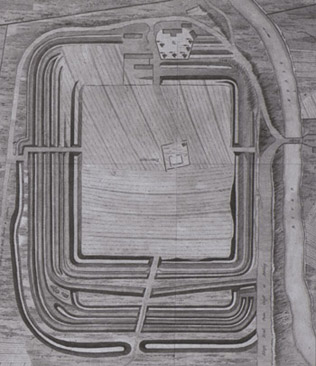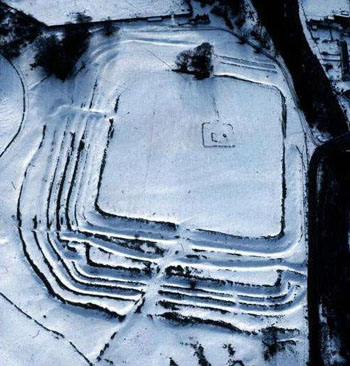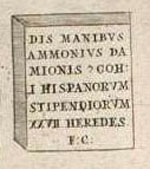‘This Fort at Ardoch I recommend to the Publik as the most entire
and best preserved of any Roman antiquity of that kind in Britain’.
So wrote Alexander Gordon in 1726, and his words remain true today. Overlain
by a medieval chapel, and later preserved in the parkland of an eighteenth
century estate, the earthworks at Ardoch have escaped the levelling by
agriculture which has denuded almost every other Roman fort in Scotland.


Plan of Ardoch by General William Roy,
published in 1793.
© Author's collection
Aerial photograph of the Roman fort at
Ardoch. A thin covering of snow highlights the multiple banks and ditches.
© SCRAN/RCAHMS
The fort was surveyed in the mid-eighteenth century by William Roy, who also recorded the extensive temporary works in its vicinity. In 1896-7 it was excavated by J.H. Cunningham on behalf of the Society of Antiquaries of Scotland, who discovered (or, more accurately, his anonymous Clerk of Works discovered) for the first time that the foundation slots and post holes of timber buildings could be detected by changes in the colour and texture of the soil. This allowed the plans of these long-vanished buildings to be traced out. The results, however, confused these early excavators, for they failed to understand that they were dealing not with one phase of buildings, but with several overlapping ones. Not until James Curle excavated the fort at Newstead a decade later was the technique of untangling these chronological sequences developed.
We now know that Ardoch was occupied by the Romans on at least three occasions. The first fort was built in the early 80s, probably during the campaigns of Agricola. It was evacuated in 86 or 87, following the abandonment of the legionary fortress at Inchtuthil and the withdrawal to southern Scotland. During the Antonine reoccupation of Scotland in 139-42 the fort was recommissioned, reduced somewhat in area. There was a brief hiatus in the late 150s, during which the fort was briefly relinquished, only to be reoccupied until the early 160s. After that it was given up for good.
Ardoch is one of a chain of garrisons set along the Roman road which runs from Camelon on the Forth to Bertha on the Tay. In the late first century it appears to have been part of a frontier system of which remains have been identified along the Gask Ridge and elsewhere.
During the seventeenth century a Roman tombstone (right) was found at Ardoch. It is dedicated to the Divine Shades (deities of the underworld) in memory of Ammonius son of Damio, who belonged to the First Cohort of Spaniards. He had served in the army for 27 years.

Detail from a drawing by J Adair, c.1690
© SCRAN/National Library of Scotland